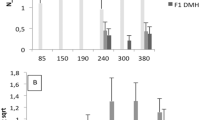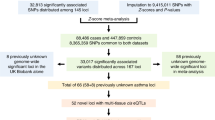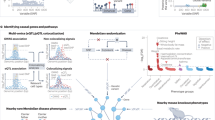Abstract
Epidemiological studies have found air pollution to be associated with excessive mortality, particularly death from respiratory and cardiovascular causes1,2. Interpretation of these findings is controversial, however, because toxicological mechanisms controlling mortality are uncertain. Susceptibility to many air pollutants entails an oxidative stress response3,4. Accordingly, the best-characterized oxidant air pollutant is ozone5, which causes direct oxidative damage of lung biomolecules6. An underlying characteristic derived from clinical and epidemiological studies of healthy and asthmatic individuals of all ages is marked variability in the respiratory effects of ozone7–11. This susceptibility difference among humans suggests that genetic determinants may control predisposition to the harmful effects of ozone12. Mice also vary considerably in their response to ozone13"15. Moreover, ozone-induced differences in strain responses16 indicate that susceptibility in mice can be genetically determined. Therefore, we used inbred mice to investigate the genetic determinants of acute lung injury. Recombinant inbred (Rl) strains derived from A/J (A) mice (sensitive) and C57BL/6J (B) mice (resistant) showed a continuous phenotypic pattern, suggesting a multigenic trait. Quantitative trait locus and Rl analyses suggested three major loci linked to ozone susceptibility. Differences in phenotype ratios among the reciprocal back-crosses were consistent with parental imprinting. These findings implicate various genetic and epigenetic factors in individual susceptibility to air pollution.
This is a preview of subscription content, access via your institution
Access options
Subscribe to this journal
Receive 12 print issues and online access
$209.00 per year
only $17.42 per issue
Buy this article
- Purchase on Springer Link
- Instant access to full article PDF
Prices may be subject to local taxes which are calculated during checkout
Similar content being viewed by others
References
Ostro, B.D. The association of air pollution and mortality: examining the case for inference. Arch. Environ. Health. 48, 336–342 (1993).
Pope, C.A. III, Dockery, D.W. & Schwartz, J. Review of epidemiological evidence of health effects of particulate air pollution. Inhalation Toxicology. 7, 1–18 (1995).
Kehrer, J.P. Free radicals as mediators of tissue injury and disease. Crit. Rev. Toxicology. 23, 21–48 (1993).
Halliwell, B. & Cross, C.E. Oxygen-derived species: their relation to human disease and environmental stress. Environ. Health Perspect. 102 (Suppl. 10), 5–12 (1994).
Lippmann, M. Ozone in Environmental Toxicants: Human Exposures and Their Health Effects (ed Lippmann, M.). 465–519 (Van Nostrand Reinhold, New York, 1993).
Mustafa, M.G. Biochemical basis of ozone toxicity. Free Radical Biol. Med. 9, 245–265 (1990).
Silverman, F. Asthma and respiratory irritants (ozone)Environ. Health Perspect. 29, 131–136 (1979).
et al. Effects of ozone on the pulmonary function of children.Adv. Mod. Environ. Toxicol. 5, 423–446 (1983).
Spektor, D.M. et al. Effects of ambient ozone on respiratory function in healthy adults exercising outdoors. Am. Rev. Respir. Dis. 138, 821–828 (1988).
Kreit, J.W. et al. Ozone-induced changes in pulmonary function and responsiveness in asthmatics. J. Appl. Physiol. 66, 217–222 (1989).
McBride, D.E., Koenig, J.Q., Luchtel, D.L., Williams, P.V. & Henderson, W.R. Jr., Inflammatory effects of ozone in the upper airways of subjects with asthma. Am. Rev. Respir. Crit. Care Med. 149, 1192–1197 (1994).
McDonnell, W.F. Intersubject variability in human acute ozone responsiveness. Pharmacogenetics. 1, 110–113 (1991).
Kleeberger, S.R., Bassett, D.J.P., Jakab, G.J. & Levitt, R.C A genetic model for evaluation of susceptibility to ozone-induced inflammation. Am. J. Physiol. 258, L313–L320 (1990).
Kleeberger, S.R., Levitt, R.C. & Zhang, L.-Y. Susceptibility to ozone-induced inflammation. I. Genetic control of'the response to subacute exposure. Am. J. Physiol. 264, L15–L20 (1993).
Stokinger, H.E. Evaluation of the hazards of ozone and oxides of nitrogen:factors modifying toxicity. Arch. Ind. Health. 15, 181–190 (1957).
Goldstein, B.D., Lai, L.Y., Ross, S.R. & R Susceptibility of inbred mouse strains to ozone.Arch. Environ. Health. 27, 412–413 (1973).
Taylor, B.A. in Origins of Inbred Mice (ed. Morse, H.C., III) 423–438(Academic, New York, 1978).
Manly, K.F. & Elliott, R.W. RI Manager, a microcomputer program for analysis of data from recombinant inbred strains. Mamm. Genome. 1, 123–126 (1991).
Nesbitt, M.N. & E Recombinant inbred mouse strains derived from the A/J and C57BL/6J: a tool for the study of genetic mechanisms in host resistance to infection and malignancy. J. Leukocyte Biol. 36, 357–364 (1984).
Marshall, J.D. et al. The AXB and BXA set of recombinant inbred mouse strains. Mamm. Genome. 3, 669–680 (1992).
DeSanctis, G.T. et al. Quantitative locus analysis of airway hyperresponsiveness in A/J and C56BL/6J mice Nature Genet. 11, 150–154 (1995).
Lincoln, S.E., Daly, M.J. & Lander, E.S. Mapping Genes Controlling Quantitative Traits with MAPMAKER/EXP 1.1, 2nd ed. (Whitehead Institute Technical Report, Cambridge, Massachusetts, 1992).
Paterson, A.H. et al. Mendelian factors underlying quantitative traits in tomato: comparison across species, generations, and environments. Genetics. 127, 181–197 (1991).
Lander, E. & Kruglyak, L. Genetic dissection of complex traits: guidelines for interpreting and reporting results. Nature Genet. 11, 241–247 (1995).
Cattanach, B.M. & J. Genetic imprinting in the mouse: implications for gene regulation.J. Inherited Metab. Dis. 17, 403–420 (1994).
Sapienza, C., Paquette, J., Pannunzio, P., Albrechtson, A. & Morgan, K. The polar-lethal ovum mutant gene maps to the distal portion of mouse chromosome 17. Genetics. 132, 241–246 (1992).
Copeland, N.G. et al. Genome maps IV: The mouse. Science. 262, 67–82 (1993).
Special report. Mamm. Genome. 6, S1–S352 (1996).
Peden, D.B. et al. Uric acid is a major antioxidant in human nasal airway secretions. 87, 7638–7642 (1990).
Cross, C.E., van der Vliet, A., O'Neill, C.A., Louie, S. & Halliwell, B. Oxidants, antioxidants, and respiratory tract lining fluids. Environ. Health Perspect. 102 (Suppl. 10), 185–191 (1994).
Author information
Authors and Affiliations
Rights and permissions
About this article
Cite this article
Prows, D., Shertzer, H., Daly, M. et al. Genetic analysis of ozone-induced acute lung injury in sensitive and resistant strains of mice. Nat Genet 17, 471–474 (1997). https://doi.org/10.1038/ng1297-471
Received:
Accepted:
Issue Date:
DOI: https://doi.org/10.1038/ng1297-471
This article is cited by
-
The lung response to ozone is determined by age and is partially dependent on toll-Like receptor 4
Respiratory Research (2015)
-
Update in the methodology of the chronic stress paradigm: internal control matters
Behavioral and Brain Functions (2011)
-
The sensitivity of murine spermiogenesis to miglustat is a quantitative trait: a pharmacogenetic study
Reproductive Biology and Endocrinology (2007)
-
Quantitative trait analysis of the development of pulmonary tolerance to inhaled zinc oxide in mice
Respiratory Research (2005)
-
Genetically modified mouse models for pharmacogenomic research
Nature Reviews Genetics (2004)



